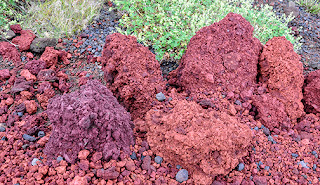Completing The Loop
This is a crater lake not far from our B&B in Reykholt.
It is worth the while to take a walk around the top or around the lake below.
It is as richly coloured as it is wild.
When a volcano crater plugs up with debris falling into the magma chamber the rain water fills the funnel creating a crater lake.
Those lake are always colourful - because they contain minerals and they are "warm" enough to support growth of algae.
Those lake are always colourful - because they contain minerals and they are "warm" enough to support growth of algae.
We left "our" Reykholt (there are several municipalities by this name in Iceland) to take a look at two special features in its neighborhood. The first one was a spectacular set of waterfalls on Hvítá river.
We are in the vicinity of the black circle on this map of fissures. The map had been photographed at the tourist center by the waterfalls below - GULLFOSS - the Golden Falls
Waters of Hvítá river are cascading down in two large steps (11m and 22m) before being channelled into deep and narrow canyon downstream.

Fear not: the article is a poster displayed by the falls - there was a time when someone came with a "bright idea" to dam this spectacular gem. Thankfully the developer-to-be ran out of money before the project could be started.
The Icelandic government decided to protect the area as a nature reserve (1979).
Gullfoss became one of the most visited features in Iceland.

The main attraction is Strokkur, a bautiful spring that erupts every 10 minutes or so. It announces itself with a rising bubble of turquoise waters, then shoots up to about 20 to 40 meters before being sucked back under the ground.
If geysirs are not enough, there are pools of turquoise steaming springs; all beautifully complementing their ocher background.
lake contains geothermal springs under its surface, making it a popular swimming spot with some warm patches along the shoreline year-round.
We are nearing the completion of our Icelandic journey - just a quick stop at another magical place - Laugarvatn; a town and a lake of the same name.Laugarvatn is a lake undermined by hot springs - a free and natural geothermal vast pool of water suitable for swimming year-round.

 There is a Spa and accomodations but we have to pass this time .....
There is a Spa and accomodations but we have to pass this time .....Only a short walk in the rain and sizzling steam must do - once again "the next-time wish".

Water by the edge of the lake is mad-hot. It is boiling so hard that one must be careful not to get too close.
And ... from Laugarvatn back to Þingvellir - the trip is completed .....back to the place of birth of the Icelandic nation. And back to the drifting continents. Stan and Lucia will fly to their European home and we will return to North America. Here we could connect the two with our outstreched arms. There .... well, we will have to rely on airplanes.
ÞINGVELLIR NATIONAL PARK is ahead














































